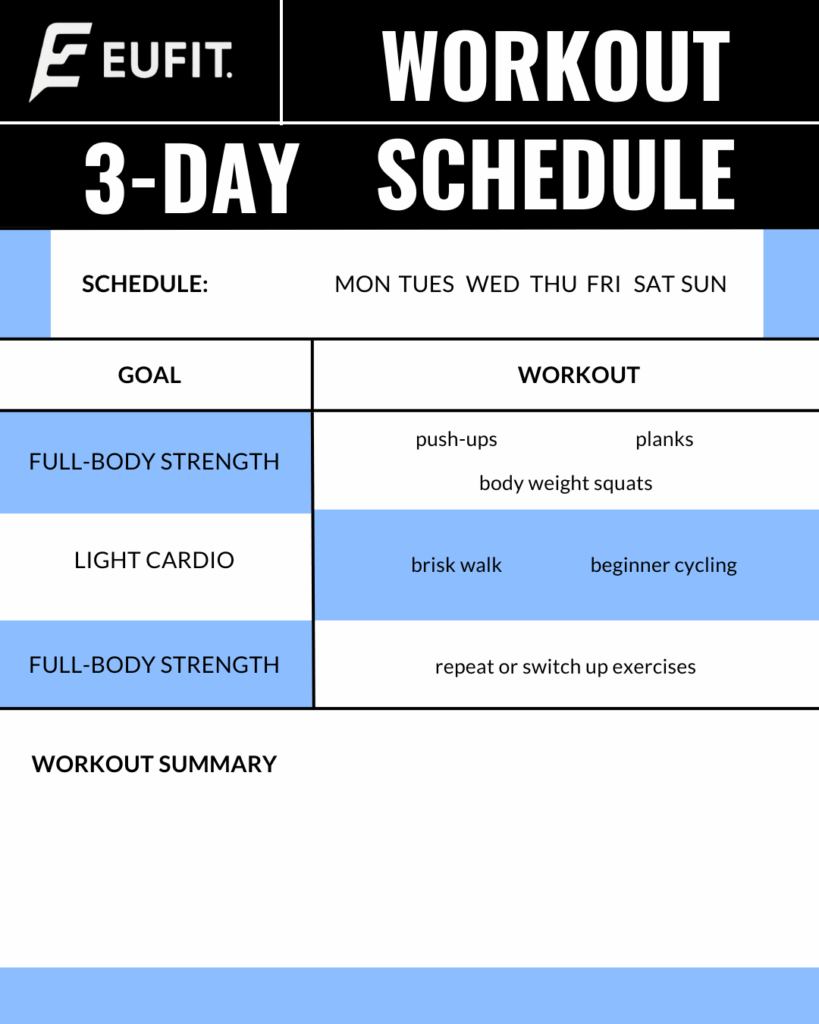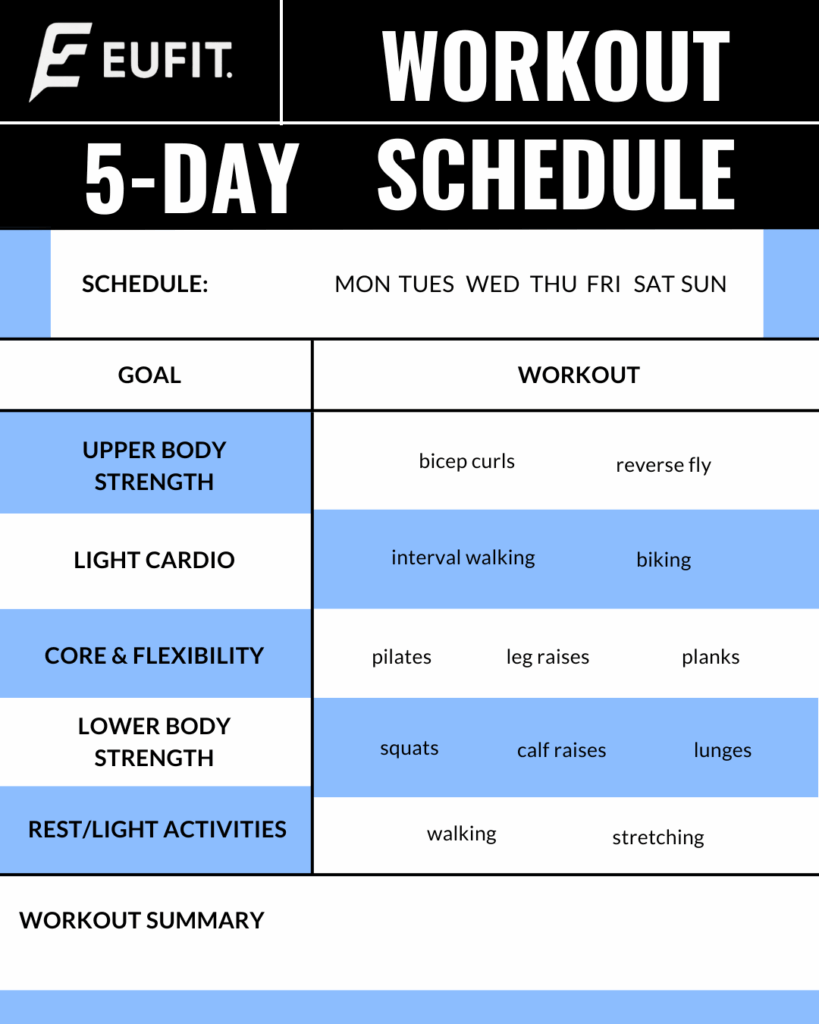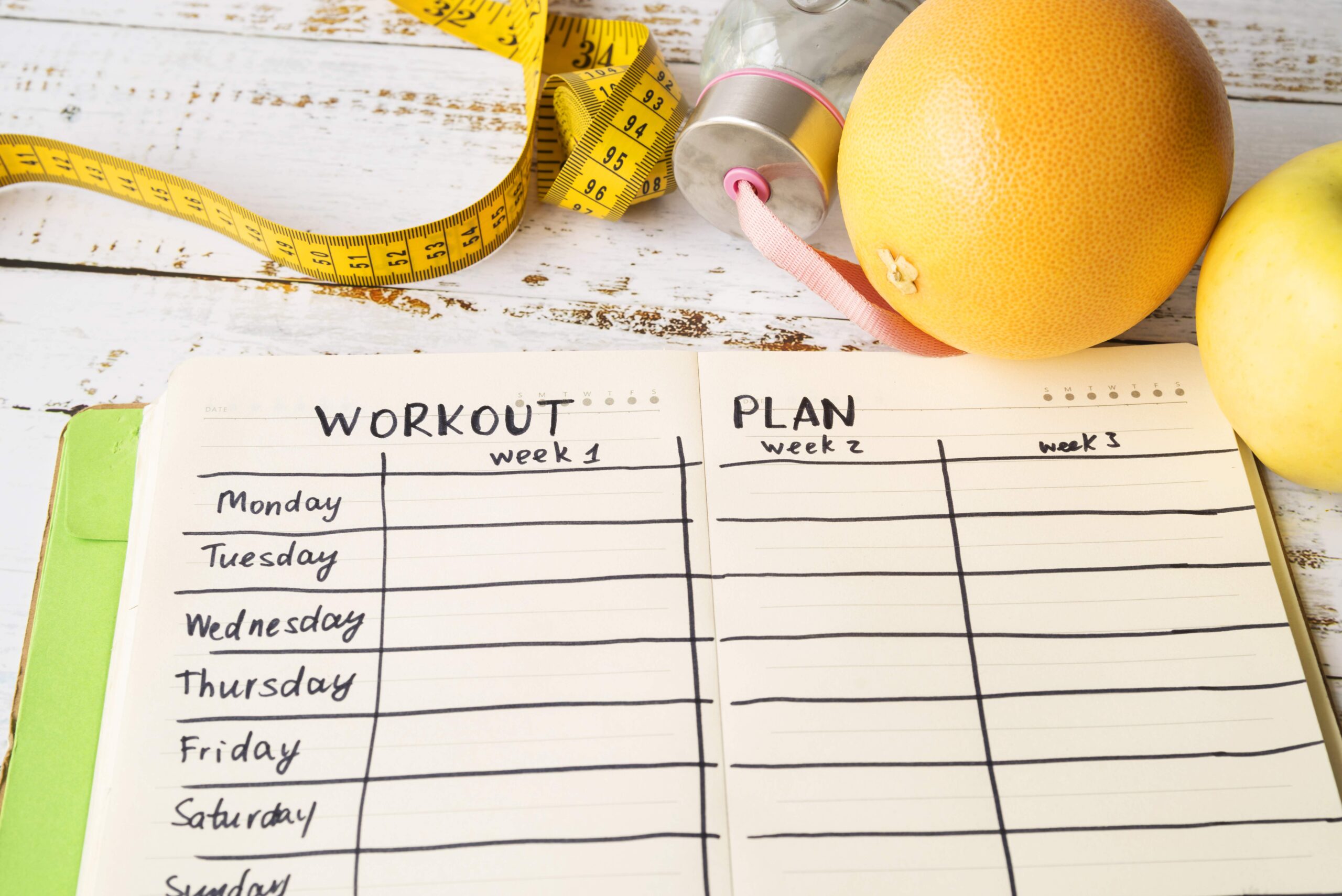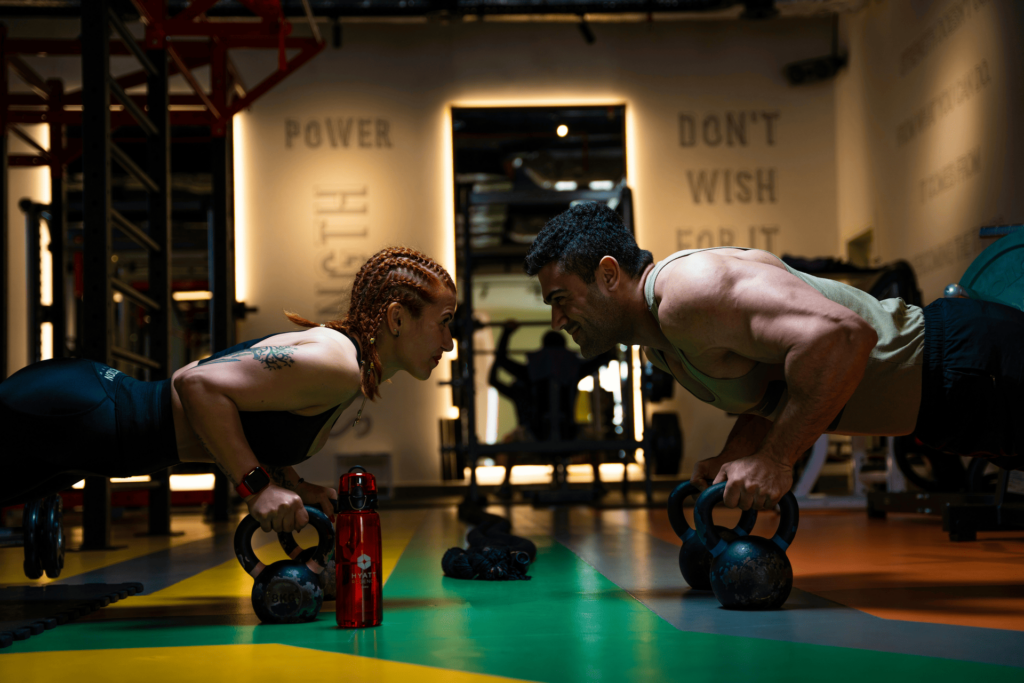Are you a beginner in finding a suitable workout schedule? You’re not alone! Everyone starts somewhere, and one of the best ways to gradually build strength and confidence is by following a realistic and achievable beginner workout schedule. Do not let what you see on social media overwhelm you; those outcomes are the product of hard work, patience, and consistency.
Starting a workout schedule can be both exciting and overwhelming. One of the most common questions beginners ask is, “How many days a week should I workout?” The answer to this question can shape your long-term results, motivation, and overall fitness journey.
In this article, we’ll explore how often you should work out as a beginner, what factors to consider when building your schedule, and provide sample workout plans to help you get started confidently.
Why Does a Workout Schedule Matter to Beginners?
A workout schedule is more than just a checklist of exercises. It’s your personal roadmap.
A plan that guides your progress, helps build healthy habits and keeps you focused on your goals.
Without a schedule, it’s easy to lose track, miss workouts, or feel aimless.
Having a workout schedule has several benefits, including:
- Builds discipline and consistency: Committing to a regular schedule makes working out a part of your lifestyle.
- Encourages steady and manageable progress: Planned progression prevents plateau and keeps your body challenged.
- Reduces the risk of burnout or injury: Structured rest and variation will reduce the risk of overtraining.
- Makes it easier to track improvements over time: Tracking sets, reps, and cardio duration helps you see real progress and stay encouraged.
- Boosts motivation by giving a sense of direction and purpose: Nothing feels better than ticking off a complete workout! Boost yourself in many aspects, and of course, make life healthier and happier.
Having a workout schedule turns guesswork into a goal-oriented routine.
What Should You Consider Before Deciding How Often to Work Out?
Before you decide how many days you want to work out, ask yourself these important questions and consider the following important factors:
Understand your fitness goals.
Understanding your goals gives your workout purpose, do you want to:
- Lose weight?
- Build muscle?
- Increase endurance?
- Improve flexibility or mobility?
Your fitness goal determines the types of exercises you do and how often you should workout, for instance:
- Weight loss: Focus on cardio and some strength training, 3 to 5 days a week.
- Muscle gain: Prioritize strength training with rest days, about 4 days a week.
- General fitness: A balanced routine of strength, cardio, and flexibility 3 to 4 times a week works well.
Determine how much time you can dedicate.
Being realistic about your schedule helps avoid frustration and burnout. Can you commit to 30 minutes a day, or is an hour feasible? Even short, consistent sessions are better than sporadic, intense ones.
You don’t need hours in the gym. Start small and build up. If you can only manage 10 minutes a day, that’s a great start.
Assess your fitness level.
Your current fitness level will influence how much your body can handle. If you’re sedentary or returning after a long break:
- Start with 2 to 3 days a week.
- Focus on low-impact exercises.
- Gradually increase intensity and volume.
If you’ve been lightly active, you may start at 3 to 4 days.
Let your body recover.
Recovery is where growth happens. Your muscles repair and strengthen during rest. Overtraining leads to fatigue, soreness, and even injury.
Beginners should:
- Take at least one rest day between strength training sessions.
- Include active recovery (like walking or stretching).
- Listen to your body, tiredness or soreness are signs to slow down.
Is Working Out Everyday Good for Beginners?
No, not really. While enthusiasm can run high at the beginning of any fitness journey, beginners often overlook one critical aspect: REST.
Overtraining too soon may result in soreness, mental burnout, or even injury.
A beginner runner said, “I started running a few months ago without any plan. At first, I tried to run every day, but I kept getting sore and frustrated. Eventually, I settled on a rhythm: three runs a week with stretching before and after. I feel stronger and more engaged now.
While a gym-goer shared his intense start, “I went into weightlifting hardcore from day one, training arms five days in a row. My muscles were unable to keep up. Following two weeks of exhaustion, I had to stop completely. I realized I needed to slow down.”
These stories are strong reminders that progress does not come from doing more. It comes from doing what’s right for your body. Consistency and sustainability go hand in hand. Trying to force rapid results often backfires.
That said, rest days don’t mean lying around all day. Light activities like walking, stretching, or gentle yoga can keep your body moving while still supporting recovery. These active rest days help promote blood flow and reduce stiffness without adding stress to your muscles.
Ultimately, a balanced routine is what sets you up for long-term success. Listen to your body, pace yourself, and aim for steady improvement.
How Often Should Beginners Workout Per Week?
It is ideal for beginners to do workouts 3 to 5 days per week.
This allows you to build strength, improve endurance, and stay consistent without overloading your body.
- 3 days a week: Great for complete beginners. Focus on full-body workouts with rest days in between to recover.
- 4 days a week: Suitable for those who have a bit more time or want faster results. Add in some cardio or flexibility sessions.
- 5 days a week: For motivated beginners, this schedule allows you to target different muscle groups while mixing in cardio and flexibility.
Avoid working out six or seven days a week without professional guidance. Rest days are just as important as training days.
Sample Beginner Workout Schedules to Help You Stay Consistent
Not sure when to start or how often to workout? We’ve got you.
These sample plans are designed to help beginners ease into a routine while staying balanced and avoiding burnout.
Perfect if you’re just getting started or juggling a busy week. It focuses on full-body strength and light cardio with enough recovery in between.

Ready to commit a little more time? This plan adds upper and lower body splits, core work, and active recovery so you stay strong and balanced.

These schedules balance movement and rest, offering enough variation to keep things interesting while helping you stay consistent. Remember: The best workout plan is the one you can stick to. Use these schedules as a guide, listen to your body, and celebrate small wins along the way.
What Types of Workouts are Best for Beginners?
Starting your fitness journey does not mean diving into intense training right away. In fact, even if you are following a workout plan with the “right” schedule, pushing too hard too soon can still set you back.
The real key is to build a strong foundation with approachable workouts that improve endurance, strength, and flexibility without overwhelming your body. Taking it slow allows your muscles, joints, and stamina to adapt safely and sustainably.
Here are the best types of workouts every beginner should include in their routine:
Low-Impact Cardio (to build stamina).
Cardio exercises help improve heart health, boost energy levels, and support weight management. You don’t need to run a marathon, there are plenty of enjoyable low-impact core exercises that ease you in.
Great beginner cardio options include:
- brisk walking
- dancing
- cycling
- jump rope (start slow and short)
- swimming or water aerobics
Start with 15 to 20 minutes, gradually working your way up to 30 to 45 minutes, 2 to 3 times per week.
Bodyweight Strength Training (no gym required).
Developing strength early on improves posture and stability, and prevents injuries. These bodyweight exercises don’t require equipment and help you develop control, coordination, and foundational strength.
Effective bodyweight moves to try:
- Squats
- Push-ups (wall, or knee if needed)
- Lunges
- Planks
- Glute bridges
Focus on form, not how many reps or how heavy the weights are. Mastering technique now makes it easier to progress with later reps and weights.
Intro to Resistance Training (for muscle development).
If you are ready to take it a step further, resistance training helps build muscle and bone strength. Beginners can ease into it with minimal equipment.
You can start with:
- Resistance bands
- Light dumbbells (2 to 5 kg)
- Simple compound exercises like bent-over rows, overhead presses, and deadlifts (with proper form or supervision)
Stick to full-body routines 2 to 3 times a week to avoid overtraining.
Core and Flexibility Workouts (for stability and recovery).
A strong core supports balance and protects your spine, while flexibility reduces the risk of injury. These exercises support posture and improve overall mobility. It can also accelerate recovery and enhance your body’s overall well-being after other training sessions.
Beginner-friendly exercises include:
- Yoga (basic poses)
- Pilates routines
- Static and dynamic stretching routines
- Ab-focused movements (crunches, leg raises, seated twists)
Even dedicating 5 to 10 minutes a day to flexibility can make a huge difference in how you move and feel.
A well-rounded beginner routine encompasses cardio, strength, flexibility, and core exercises.
Start small, rotate between types throughout the week, and give your body time to rest and adjust.
This holistic approach not only builds physical fitness but also sets the foundation for long-term progress and consistency.
How Can Beginners Stick with their Workout Schedules?
Starting is one thing. Sticking with it? That’s where magic happens. It is easy to get excited at the beginning of your fitness journey, but the real results come from consistency. So, how can beginners stay on track without feeling overwhelmed or burning out?
Start small and stay consistent.
Trying to do too much too often leads to burnout. Begin with 2 to 3 days a week and add more as it becomes a habit.
Once that becomes a part of your routine, you can gradually add more. Think of it like leveling up, not racing to the finish line.
Set a routine that fits your lifestyle.
Choose specific days and times for your workouts and treat them like appointments. Whether it is early mornings before work or short sessions after dinner, consistency builds habit.
Write it down, or set calendar or phone reminders, whatever helps you commit.
Track your progress.
Trying to do too much too soon often leads to burnout. Begin with 2 to 3 days a week and add more as it becomes a habit.
Once that becomes a part of your routine, you can gradually add more. Think of it like leveling up, not racing to the finish line.
Do what you enjoy.
You won’t stick to a routine you dread. Don’t like running? Don’t run! Find something enjoyable: try dance workouts, hiking, swimming, or join a beginner group class.
The best workout is the one you want to do, and you’re more likely to stick with something you enjoy.
Listen to your body.
Muscle soreness is normal, but sharp pain isn’t. Learn to tell the difference.
Take rest days when needed. Rest is productive.
Gentle stretching, hydration, and good sleep all support recovery. Your body builds strength during rest just as much as during movement.
Avoid the comparison trap.
Everyone’s journey is different. Stay focused on your progress. Use others for inspiration, not competition.
Celebrate small wins, every push-up, step, or session counts!
Mix it up, but with intention.
If you are not sure which type of workout to commit to, alternate between cardio, strength, and flexibility throughout the week.
But if you have a goal, like improving your endurance or building muscle, focus on that type of training and level up gradually.
What to Do If You Fall Off Your Workout Schedule?
Taking a break from your workout routine is quite common. Schedules change, motivation declines, and life becomes hectic. It is important that you avoid letting guilt discourage you. Instead, focus on progress, not perfection.
One way to bounce back is by revisiting some of the top fitness motivation tips. Here’s how to confidently start over and get back on track without feeling bad about it.
- Forgive yourself quickly. You are human, and missing a day, or even a week, or a few months does not mean you have failed. Throw away the guilt. It becomes challenging to start over the more you think about the past. Be gentle to yourself and keep going.
- Reflect without judgment. Take some time to think about yourself rather than blaming yourself. What caused you to lose your way? Was your schedule too challenging? Did you become uninspired or burned out? Recognizing the “why” enables you to modify your approach rather than give up entirely.
- Start small for a quick win. Don’t force yourself to resume an intense workout schedule. Consider something simple and achievable, such as an immediate at-home workout, a 10-minute walk, or a stretch. These small achievements restore momentum and enhance confidence.
- Modify the plan. Perhaps your initial plan was excessively ambitious, and that’s okay! You can tweak it. Try completing tasks in a shorter duration, or switching to gentler activities. Being flexible helps make your workout routine endure over time.
- Celebrate your restart. Your readiness to resume is a victory by and of itself. You are starting from experience rather than from scratch. Rebooting each time helps you become more durable.
Keep in mind that progress is about consistently putting up, not about being exceptional. So don’t be afraid to reset, refocus, and carry on.
To Sum Up: What’s the Best Beginner Workout Schedule?
As a beginner, you don’t need a perfect plan. You just need a starting point and a little self-belief. It’s not about doing more, it’s about doing what’s sustainable. Begin with 3 to 5 days per week, combining cardio, strength, and flexibility. Customize your plan to align with your goals, time, and energy levels.
Build slowly, rest well, and don’t worry about perfection. Every rep, every workout brings you one step closer to your fitness goals. Be kind to yourself, and keep showing up. With self-confidence, energy, patience, structure, self-compassion, and a habit that transforms your life. You will build not just a strong body, but a lifestyle that supports long-term health and happiness.
Remember: You’ve got this! Let today be day one.


